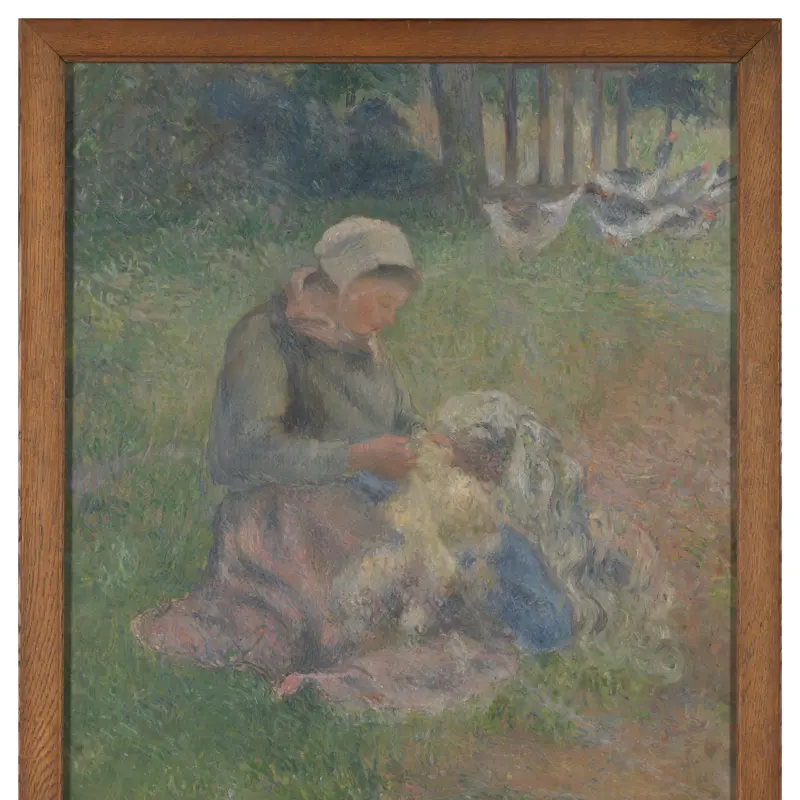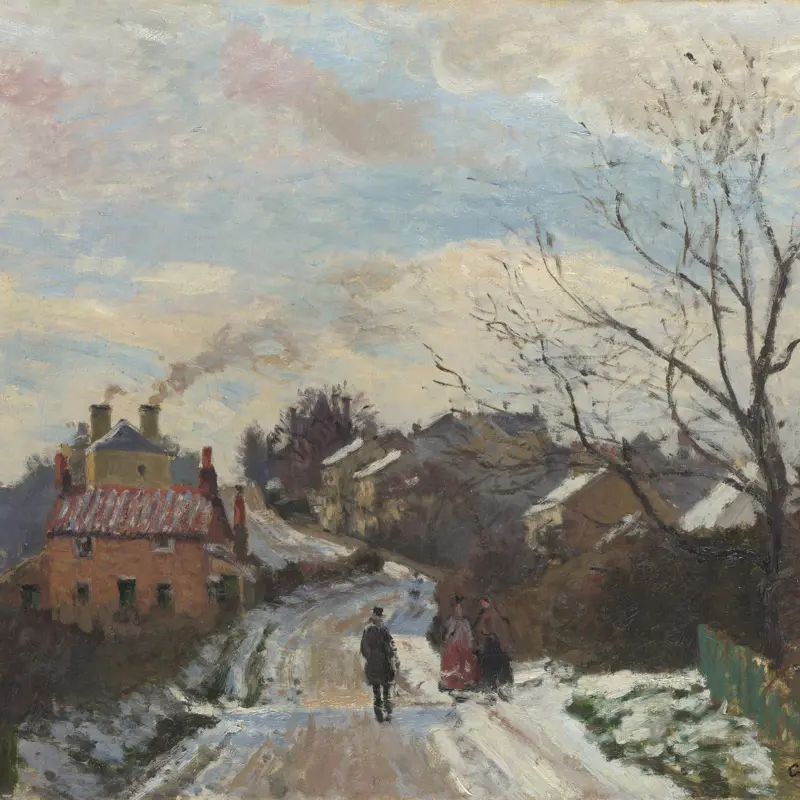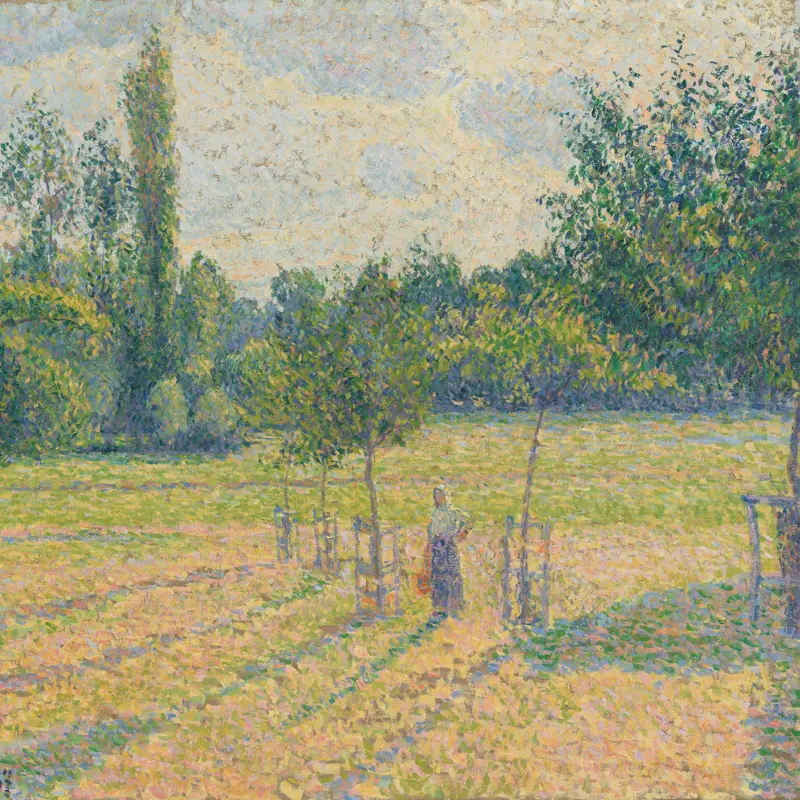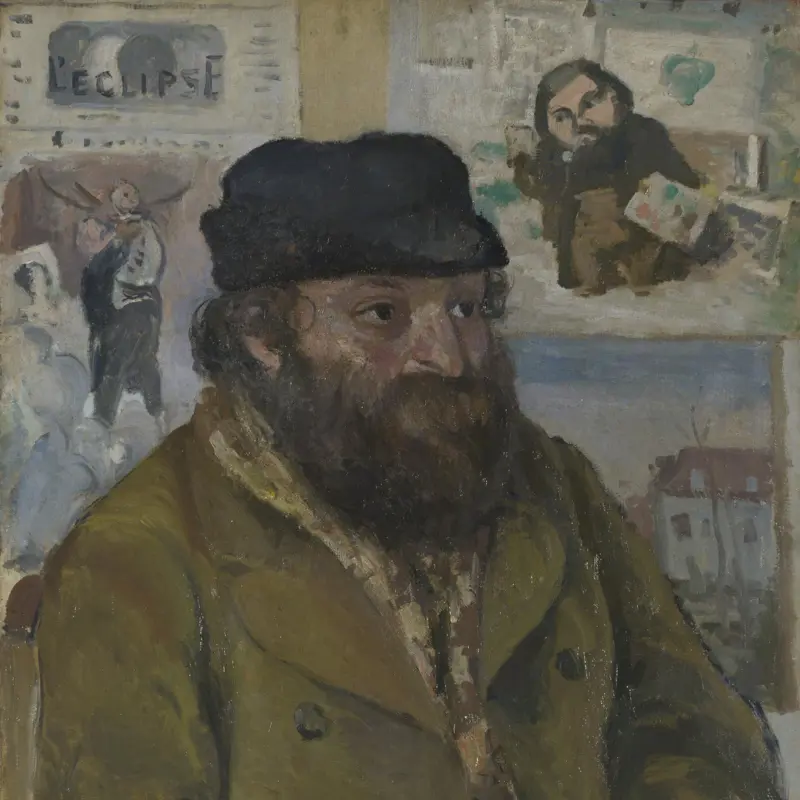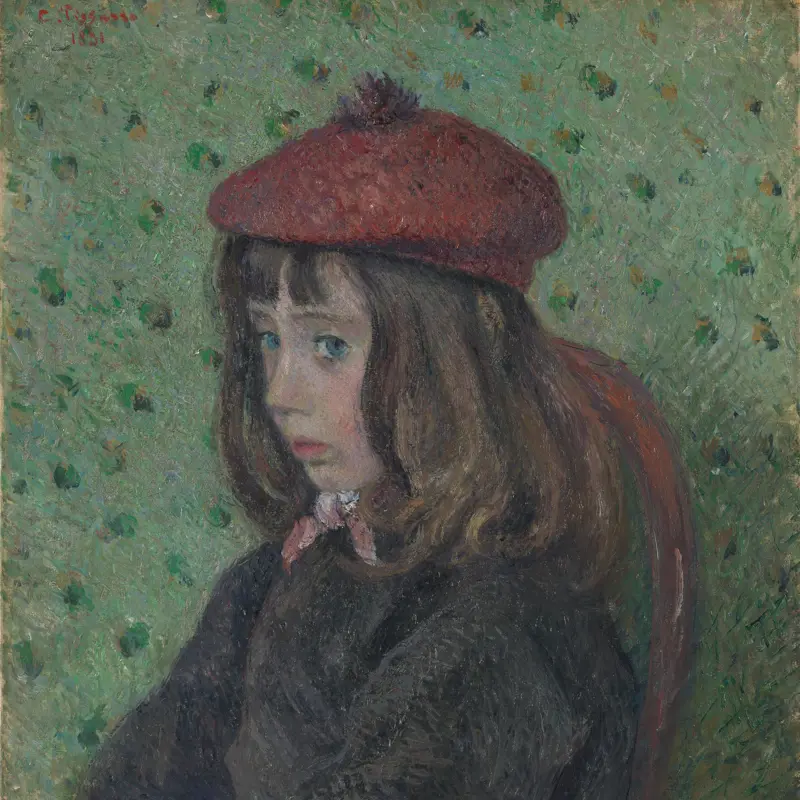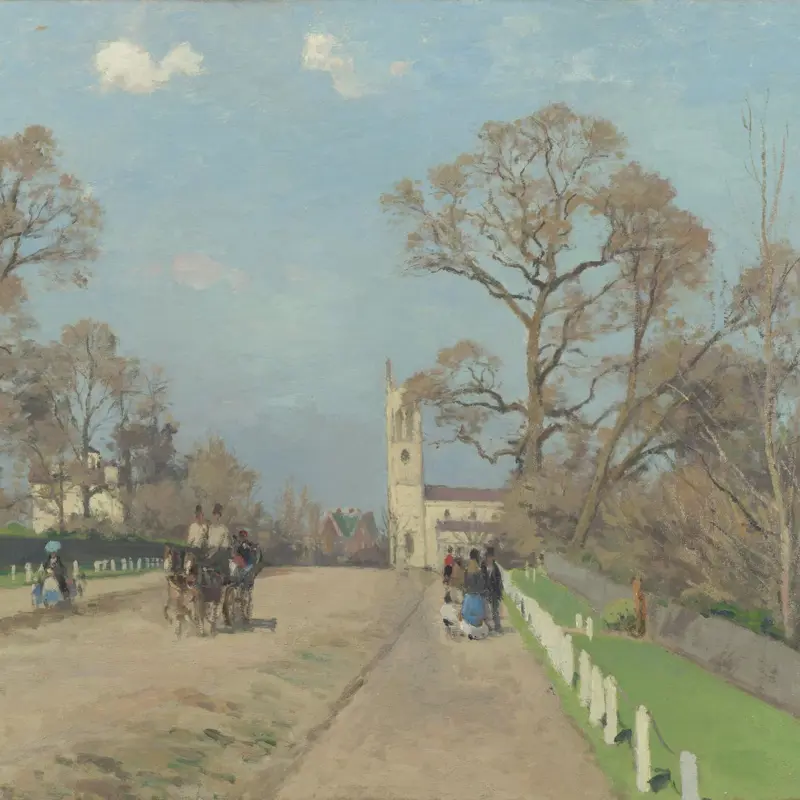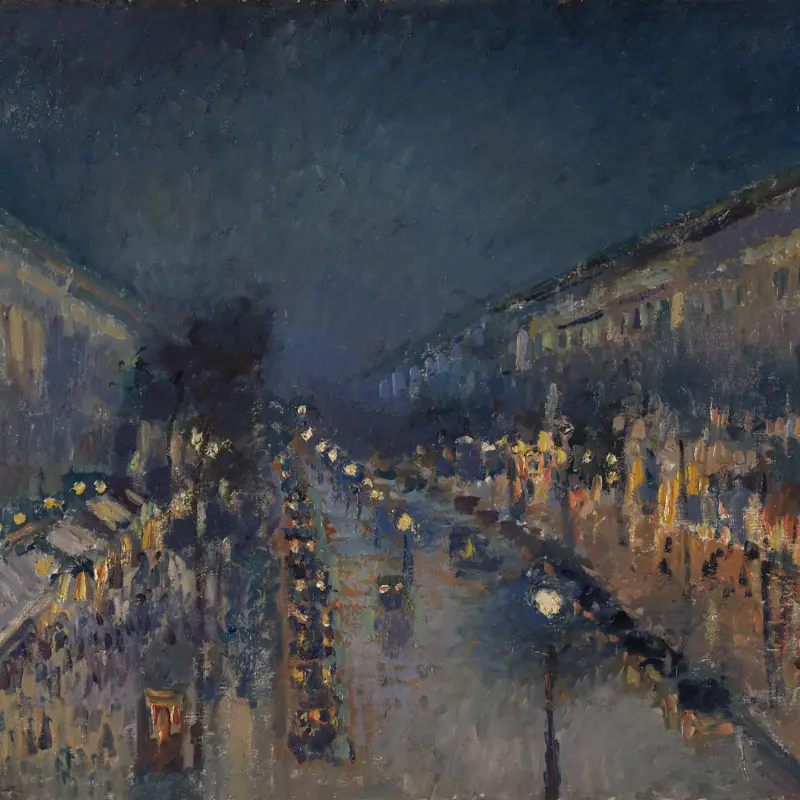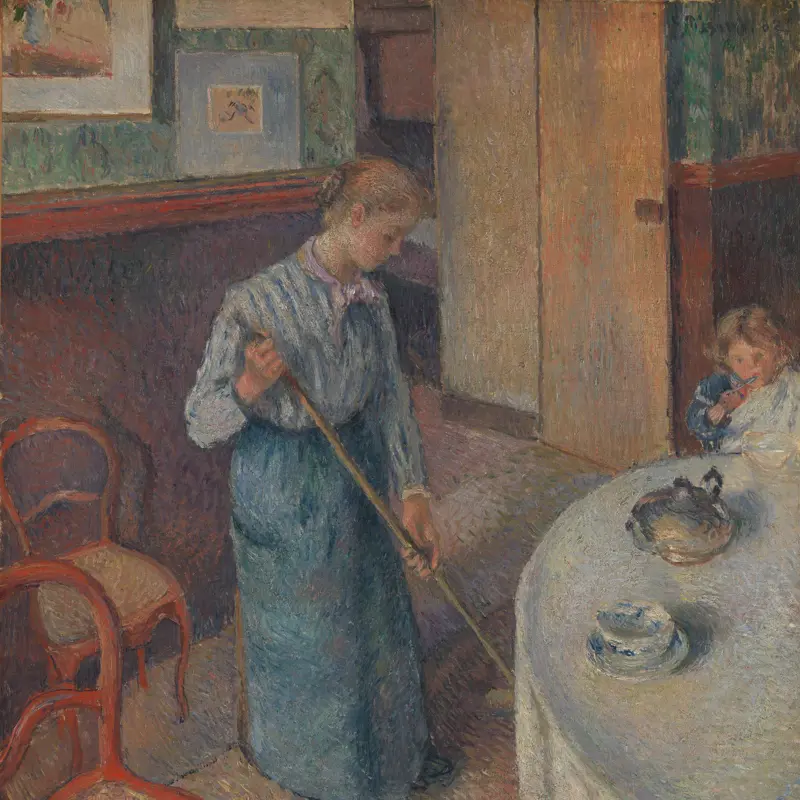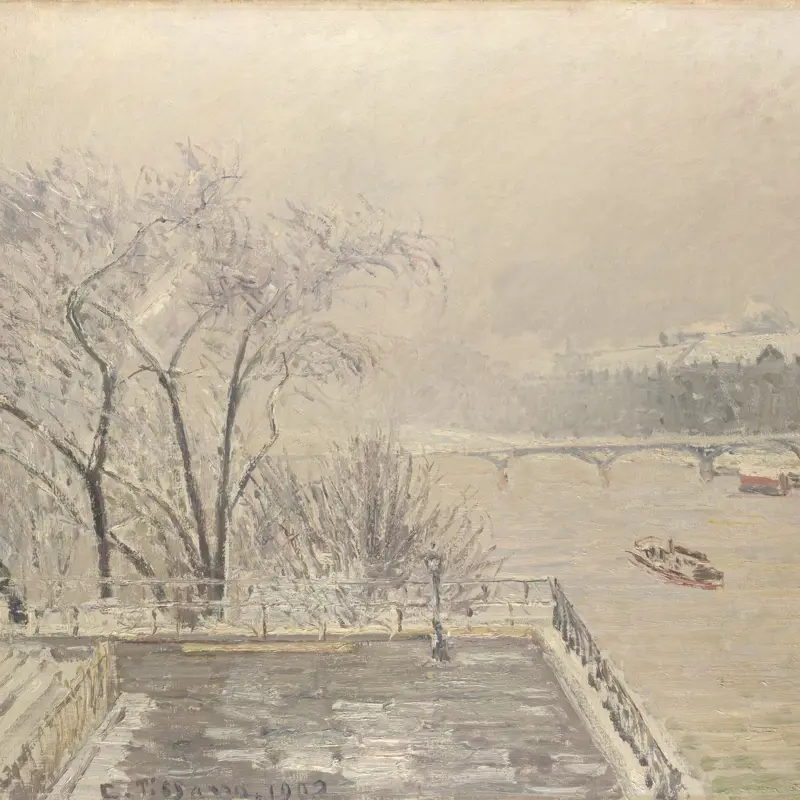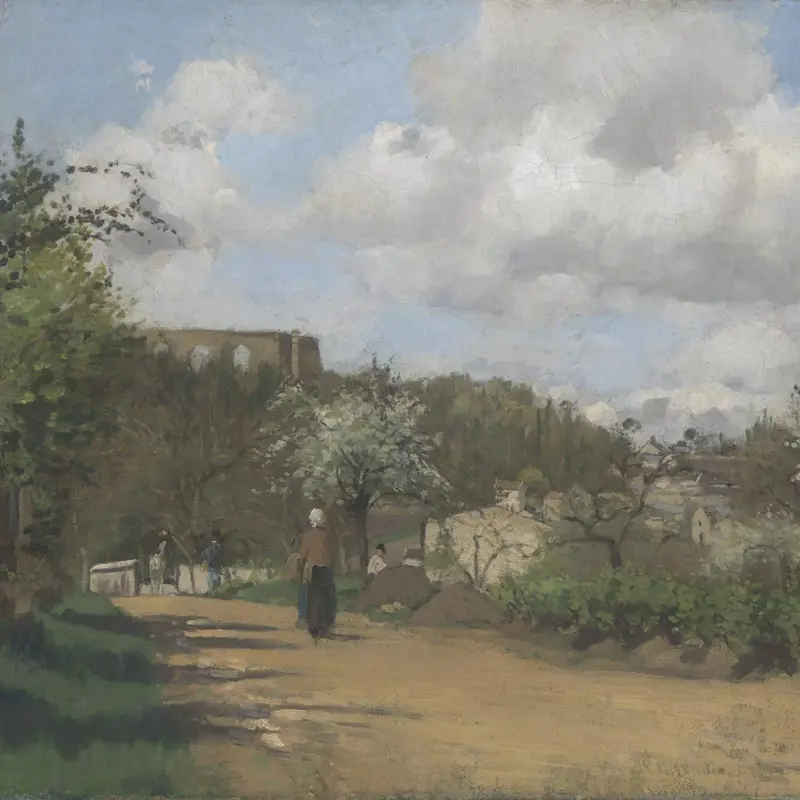Camille Pissarro, 'The Côte des Bœufs at L'Hermitage', 1877
About the work
Overview
This wooded hillside, called the Côte des Bœufs, was close to Pissarro’s home in the hamlet of L’Hermitage, near the market town of Pontoise, where he lived for most of the time between 1866 and 1883.
Although Pissarro was a leading Impressionist, this painting signals his move away from the fleeting atmospheric effects of Impressionism. Instead, he is primarily focused here on the structure of the composition, which he has carefully arranged using counterbalanced vertical and horizontal lines. The thickly applied paint and densely worked surface, which he built up with multiple small brushstrokes, is also quite distinct from the swift fluid brushwork and sketch-like qualities of Impressionism.
This shift to a more structured version of Impressionism foreshadows the concerns of the next generation of Post-Impressionist artists, particularly Cezanne and Seurat.
Key facts
Details
- Full title
- The Côte des Bœufs at L'Hermitage
- Artist
- Camille Pissarro
- Artist dates
- 1830 - 1903
- Date made
- 1877
- Medium and support
- Oil on canvas
- Dimensions
- 114.9 × 87.6 cm
- Inscription summary
- Signed; Dated
- Acquisition credit
- Presented by C.S. Carstairs to the Tate Gallery through the Art Fund, 1926; transferred, 1950
- Inventory number
- NG4197
- Location
- Room 44
- Collection
- Main Collection
- Frame
- 17th-century Italian Frame
Provenance
Additional information
Text extracted from the ‘Provenance’ section of the catalogue entry in Martin Davies, with additions and some revisions by Cecil Gould, ‘National Gallery Catalogues: French School: Early 19th Century, Impressionists, Post-Impressionists, etc.’, London 1970; for further information, see the full catalogue entry.
Exhibition history
-
2010Impressionist GardensNational Gallery of Scotland31 July 2010 - 17 October 2010
-
2013Camille PissarroMuseo Nacional Thyssen-Bornemisza4 June 2013 - 15 September 2013CaixaForum Barcelona15 October 2013 - 26 January 2014
-
2021Camille Pissarro. The Studio of ModernismKunstmuseum Basel4 September 2021 - 31 January 2022
-
2022Pissarro: Father of ImpressionismThe Ashmolean Museum of Art and Archaeology17 February 2022 - 12 June 2022
Bibliography
-
1892G.-A. Aurier, 'Choses d'art: Chez Durand-Ruel', Le Mecure de France, III, 1892
-
1892C. Saunier, 'L'art nouveau: I. Camille Pissarro', La Revue indépendante, 1892, pp. 30-40
-
1914M. Hamel, 'Camille Pissarro: Exposition rétrospective de ses œuvres', Les Arts, 1914
-
1914J.-E. Blanche, Art francais: Exposition d'art décoratif contemporain 1800-1885, Paris 1914
-
1923W. Sickert, 'French Pictures at Knoedler's Gallery', The Burlington Magazine, XLIII/244, 1923, pp. 39-44
-
1924Knoedler Gallery, Exposition des peintres de l'école française du XIXe siècle, Paris 1924
-
1932Manchester Art Gallery, French Art Exhibition (exh. cat., Manchester Art Gallery, 22 March 1932 - 1 May 1932), Manchester 1932
-
1939L.-R. Pissarro and L. Venturi, Camille Pissarro: Son art et son oeuvre, Paris 1939
-
1939L. Venturi, Les archives de l'impressionnisme, Paris 1939
-
1950L. Venturi, Impressionists and Symbolists, London 1950
-
1955J. Leymarie, L'Impressionisme, Lausanne 1955
-
1957Martin Davies, National Gallery Catalogues: French School, 2nd edn (revised), London 1957
-
1970Davies, Martin, and Cecil Gould, National Gallery Catalogues: French School: Early 19th Century, Impressionists, Post-Impressionists etc., London 1970
-
1972C. Kunstler, Camille Pissarro, Milan 1972
-
1974M. Preutu, Pissarro: Monografie, Budapest 1974
-
1977R. Brettell, Pissarro and Pontoise: The Painter in a Landscape, Phd Thesis, Yale University 1977
-
1978Y. Iwasaki, Pissarro, Tokyo 1978
-
1980R.E. Shikes and P. Harper, Pissarro: His Life and Work, London 1980
-
1983A. Lant, 'Purpose and Practice in French Avant-Garde Print-Making of the 1880s', Oxford Art Journal, VI/1, 1983, pp. 18-29
-
1986C.S. Moffett, The New Painting: Impressionism 1874-1886 (exh. cat. National Gallery of Art, Washington, 17 January - 6 April 1986; The Fine Arts Museums of San Francisco, M.H. de Young Memorial Museum, 19 April - 6 July 1986), Oxford 1986
-
1990R. Brettell, Pissarro and Pontoise: The Painter in a Landscape, New Haven 1990
-
1990D. Bomford, R. White and L. Williams, Impressionism (exh. cat. The National Gallery, 1990), London 1990
-
1990R. Thomson, Camille Pissarro: Impressionism, Landscape and Rural Labour (exh. cat. Birmingham CMuseum and Art Gallery, 8 March - 22 April 1990; Burrell Collection, 4 May - 17 June 1990), Birmingham 1990
-
1992P. Smith, '"Parbleu": Pissarro and the Political Colour of an Original Vision', Art History, XV/2, 1992, pp. 223-37
-
1993R. White and J. Pilc, 'Analyses of Paint Media', National Gallery Technical Bulletin, XIV, 1993, pp. 86-94
-
1995P. Smith, Impressionism: Beneath the Surface, New York 1995
-
1996J. Rewald, W. Feilchenfeldt and J. Warman, The Paintings of Paul Cézanne: A Catalogue Raisonné, London 1996
-
2001
C. Baker and T. Henry, The National Gallery: Complete Illustrated Catalogue, London 2001
About this record
If you know more about this work or have spotted an error, please contact us. Please note that exhibition histories are listed from 2009 onwards. Bibliographies may not be complete; more comprehensive information is available in the National Gallery Library.

